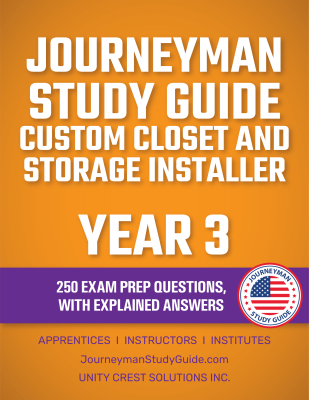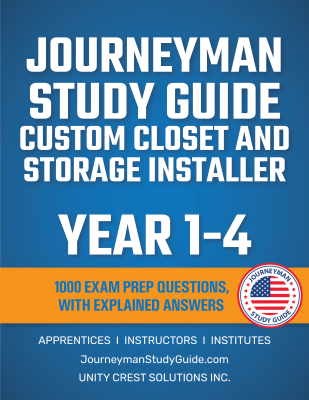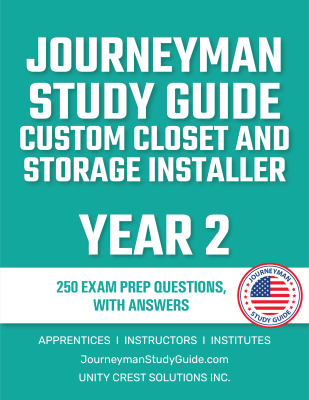Questions, Answers, & Explanations
Get clear explanations behind every answer, perfect for deeper learning and more thorough exam preparation.
Site Updates in Progress: Things might look different as we work on enhancing your experience.
What is a Custom Closet and Storage Installer?
Custom closet and storage installers design, build, and install tailored storage solutions for residential and commercial spaces. These professionals work with wood, metal, composite materials, and specialty hardware to create efficient and aesthetically pleasing storage systems. Their work is essential in optimizing closet spaces, pantries, garages, home offices, and retail displays, offering both functionality and style.
Key Responsibilities
Custom closet and storage installers must combine technical skills, attention to detail, and spatial planning expertise to complete each project successfully:
Skills and Traits for Success
Successful custom closet and storage installers must possess a blend of technical knowledge, problem-solving ability, and craftsmanship:
Industries Where Custom Closet and Storage Installers Thrive
This trade serves a growing market in home organization, luxury interiors, and commercial storage solutions:
Why Choose This Career?
A career in custom closet and storage installation offers job security, creative fulfillment, and excellent earning potential:
Get Certified and Advance Your Career
Training and certification in custom cabinetry, woodworking, and construction safety can set you apart in this field. Our Q&A study materials, online tests, and certification prep guides help you develop the knowledge and skills needed for success.
What to Expect on the Custom Closet and Storage Installer Certification Exam
The Custom Closet and Storage Installer Certification Exam evaluates a candidate’s knowledge of cabinetry, shelving installation, safety protocols, and material handling techniques. Many employers, home organization companies, cabinetry manufacturers, and residential construction firms require certification to ensure that workers meet OSHA regulations, industry standards, and client expectations.
Exam Format
The certification exam consists of multiple-choice and practical application questions covering:
Key Topics Covered
Passing Requirements
Most certifying bodies require a minimum score of 70% to pass. Some programs also include a hands-on skills assessment, where candidates demonstrate their ability to cut, assemble, and install a storage system.
Prepare with Confidence
Our Q&A study materials and interactive online tests help candidates reinforce key concepts, practice installation techniques, and improve test performance.
What Types of Questions Are on the Exam?
The Custom Closet and Storage Installer Certification Exam tests knowledge of installation techniques, safety protocols, and material selection. Understanding the format will help ensure success.
Common Question Formats
Sample Questions
Study Smarter, Pass Faster
Our Q&A products help candidates focus on critical topics, while our Q/A Explanation guides provide deeper understanding. Our Online Tests simulate exam conditions for real-time assessment.
What Is It Like to Work as a Custom Closet and Storage Installer?
A custom closet and storage installer’s workday is a balance of design, hands-on craftsmanship, and customer interaction. Each day presents new challenges, from measuring and cutting materials to assembling and installing storage solutions in homes, offices, and retail spaces. Installers must be precise, organized, and skilled in using tools and hardware to ensure high-quality results.
Morning: Planning and Preparation
Midday: Installation Process
Afternoon: Finishing Touches and Client Review
Challenges & Rewards
Ready to Start Your Career?
Prepare for certification with our Q&A products, online tests, and study guides designed to help you master installation techniques and safety standards.
What Are the Long-Term Benefits of a Career as a Custom Closet and Storage Installer?
A career in custom storage installation offers steady demand, opportunities for creativity, and strong earning potential. Many professionals advance into specialized cabinetry, woodworking, or business ownership.
Career Progression
Top Employers & Career Opportunities
Union & Certification Benefits
Why This Career Matters
Custom storage installation improves organization, functionality, and aesthetics for homes and businesses. Skilled installers bring client visions to life with custom solutions.
Take the Next Step
Advance your career with our study guides, Q&A materials, and interactive online tests tailored for custom closet and storage installers.
Page 6: Wage Expectations – Custom Closet and Storage Installer
How Much Can You Earn as a Custom Closet and Storage Installer?
Wages for custom closet and storage installers vary based on experience, location, industry specialization, and certification level. Skilled professionals can earn competitive pay in residential, commercial, and luxury design markets.
Wage Breakdown by Experience Level
Factors That Impact Earnings
Maximize Your Earning Potential
Advance your career with our Q&A study materials, certification prep courses, and interactive online tests to enhance your knowledge and improve job prospects.
Essential Tools for Custom Closet and Storage Installers
Custom closet and storage installers rely on precision tools, fastening systems, and high-quality materials to complete projects efficiently.
Must-Have Tools for the Job
Top U.S. Suppliers for Installation Equipment
Recommended Training & Certification Programs
Why the Right Tools & Training Matter
Using professional-grade tools and staying updated with industry certifications ensures efficiency, quality craftsmanship, and career longevity.
Get Equipped for Success
Prepare for certification with our study guides, Q&A resources, and interactive online tests tailored for custom storage installers.
Where Can You Train to Become a Custom Closet and Storage Installer?
Education and training programs for custom closet and storage installers focus on carpentry, cabinetry, and construction safety. Many programs include hands-on training with power tools, blueprint reading, and material selection to prepare students for real-world job scenarios.
Types of Training Programs
What to Expect in Training Programs
How to Choose the Right Program
Advance Your Skills with Professional Training
Becoming a certified custom closet and storage installer requires technical expertise, hands-on practice, and regulatory training. Our Q&A study materials and online tests help reinforce key concepts and prepare for certification exams.
Why Join a Union or Work with a Reputable Employer?
Union membership and working with trusted employers provide job stability, competitive wages, and career growth opportunities. Custom closet and storage installers are represented by organizations such as United Brotherhood of Carpenters (UBC), which offer specialized training, benefits, and advocacy for workers.
Benefits of Union Membership
Top Unions for Custom Closet and Storage Installers
Leading Employers Hiring Custom Closet and Storage Installers
What Employers Look For
How to Get Hired as a Custom Closet and Storage Installer
Why Unions & Employers Matter
Unions and reputable employers ensure safe working conditions, competitive wages, and continuous training opportunities for custom closet and storage installers.
Secure the Best Career Opportunities
Enhance your employability by getting certified and joining a union. Use our study guides, Q&A materials, and online tests to ensure success in cabinetry and storage installation exams.
How to Stay Ahead in the Custom Closet and Storage Industry
The custom storage industry continues to evolve with advancements in materials, space-saving technology, and sustainable design. Skilled installers who stay updated with industry trends, emerging technologies, and new safety regulations will have the competitive edge needed to succeed.
Emerging Trends in Custom Closet and Storage Installation
Best Practices for Career Growth
Challenges & Opportunities in the Industry
Staying Competitive in the Job Market
The best custom closet and storage installers continuously learn, adapt, and refine their skills. Our Q&A materials, Q/A Explanation guides, and interactive online tests provide the knowledge and preparation needed to stay ahead in this evolving field.
Get clear explanations behind every answer, perfect for deeper learning and more thorough exam preparation.
Quick and easy practice to test your knowledge anytime, anywhere—ideal for simple, on-the-go preparation.










